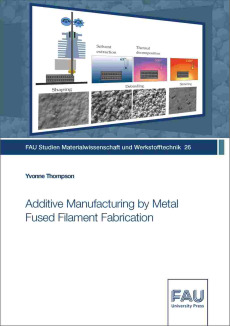Yvonne Thompson
Additive Manufacturing by Metal Fused Filament Fabrication
Reihe: FAU Studien Materialwissenschaft und WerkstofftechnikMetal fused filament fabrication (MF3) with metal-filled filaments is an indirect process that uses polymeric binders for additive shaping of green bodies. These are processed into solid metal parts after debinding and sintering. Due to the filament-based shaping,
this process can be used for the additive manufacturing of all sinterable powder materials requiring low investment costs. The MF3 process could thus provide a cost-effective and material-flexible alternative to powder bed fusion (PBF) manufacturing of small metallic components with complex shapes. To enable a successful process application, parameter optimization as well as the selection of the furnace atmosphere for each individual process step is crucial to achieve a high final density. In this context, the
applied parameters have a significant influence on the microstructure and the functional and mechanical properties of the manufactured components.
It is the aim of this work to identify suitable parameter sets for the individual process steps and to evaluate the applicability of MF3 for AM of various high-value metal alloys.
This includes a general parameter optimization for each step of the entire process chain of shaping, debinding and sintering, independently of the processed metal powder. Based on the general process implementation, systematic parameter studies were performed for 316L, Ampersint 1557.02, cp-Ti, IN 718, CoWAlloy3mod, and 99 %% pure Cu to derive the best processing strategies for each of these metals.
Das Metallextrusionsverfahren (engl. metal fused filament fabrication (MF3)) unter Verwendung metallgefüllter Filamente ist ein indirektes Verfahren, das polymere Bindemittel für die additive Formgebung von Grünkörpern verwendet, aus denen nach dem Entbindern und Sintern kompakte Metallteile hergestellt werden.
Aufgrund der filamentbasierten Formgebung kann dieses Verfahren für die additive Fertigung aller sinterfähigen Pulverwerkstoffe bei geringen Investitionskosten eingesetzt werden. Das MF3-Verfahren stellt somit eine kostengünstige und werkstoffflexible Alternative zu Pulverbettverfahren für kleine metallische Bauteile komplexer Geometrie dar. Für eine erfolgreiche Prozessanwendung sind eine Parameteroptimierung sowie die Wahl der Ofenatmosphäre für jeden einzelnen Prozessschritt entscheidend, um eine hohe Enddichte zu erreichen. In diesem Zusammenhang haben die angewandten Parameter einen wesentlichen Einfluss auf die Mikrostruktur und die funktionellen und mechanischen Eigenschaften der hergestellten Bauteile.
Ziel dieser Arbeit ist es, geeignete Parametersätze für die einzelnen Prozessschritte zu identifizieren und die Anwendbarkeit von MF3 für verschiedene hochwertige Metalllegierungen zu bewerten. Dies beinhaltet eine generelle Parameteroptimierung jedes Schrittes der gesamten Prozesskette von Formgebung, Entbindern und Sintern, unabhängig vom verarbeiteten Metallpulver. Auf der Grundlage der allgemeinen Prozessimplementierung werden systematische Parameterstudien für 316L, Ampersint 1557.02, cp-Ti, IN 718, CoWAlloy3mod und 99 %% reines Cu durchgeführt, um die besten Verarbeitungsstrategien für jedes dieser Metalle abzuleiten.
Produktinformationen
206 Seiten , Format 14,8 x 21,0FAU University Press
Paperback
29,00 € inkl. MwSt.
Erscheinungsdatum
Oktober 2023
Kategorie: Technik
